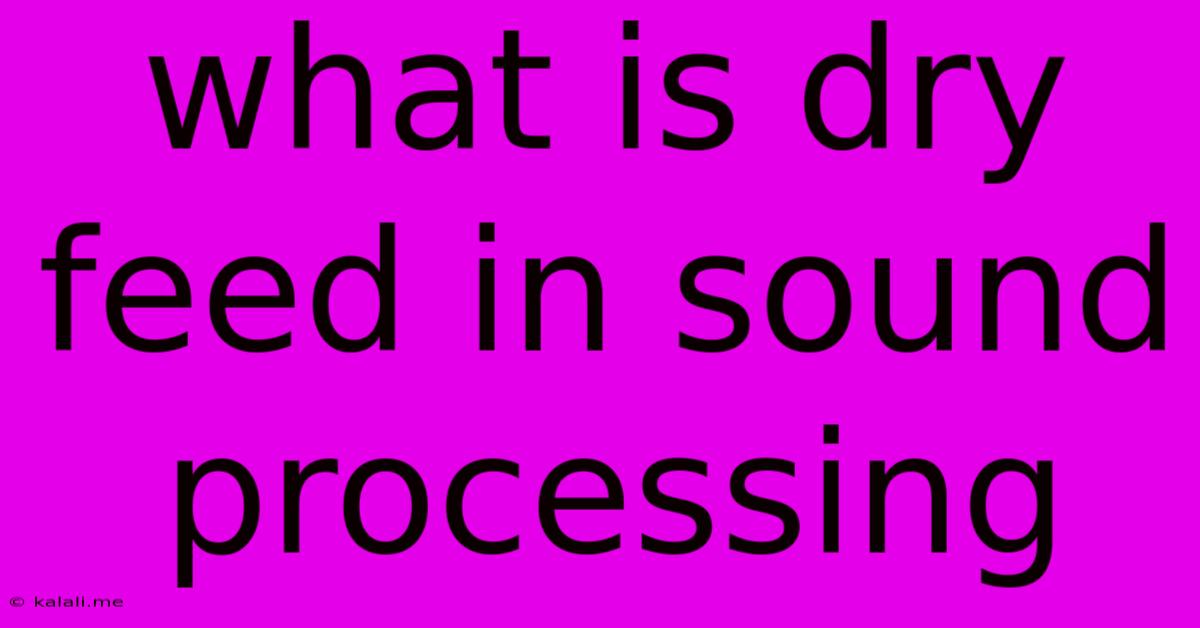What Is Dry Feed In Sound Processing
Kalali
May 23, 2025 · 4 min read

Table of Contents
What is Dry Feed in Sound Processing? Understanding the Fundamentals
Meta Description: Dive into the world of audio engineering and discover what dry feed means in sound processing. Learn how it differs from wet signals and its crucial role in achieving a balanced and professional mix. This article explains dry feed in simple terms, perfect for beginners and seasoned audio engineers alike.
In the realm of audio engineering and music production, understanding the nuances of signal processing is crucial for achieving a professional and polished sound. One such concept, often encountered in mixing and mastering, is the "dry feed." But what exactly is a dry feed, and why is it so important?
This article will demystify the concept of dry feed in sound processing, explaining its significance and how it contributes to a well-balanced and nuanced mix.
Dry vs. Wet Signals: The Core Difference
To understand dry feed, it's essential to first grasp the distinction between dry and wet signals. A dry signal is the original, unaltered audio signal. Think of it as the unprocessed sound coming directly from your instrument or microphone. It's clean, free from effects, and represents the source material in its purest form.
Conversely, a wet signal is the processed audio signal. This is your dry signal after it's passed through effects such as reverb, delay, chorus, or distortion. These effects add ambience, texture, and character to the sound, altering its original quality.
What is a Dry Feed?
A dry feed, then, is simply the unprocessed audio signal sent directly to a mixing channel or bus. It's the foundation upon which you build your processed sound. It's the pure, unaltered source material, feeding into the mix independently of any effects. You might also hear it referred to as a 'pre-fx' or 'clean' signal.
Why Use a Dry Feed?
The benefits of incorporating a dry feed into your workflow are numerous:
-
Control and Flexibility: A dry feed gives you complete control over the level and character of your processed sound. You can adjust the wet signal's effect without losing the original sonic integrity. If you later decide you want less reverb, you can simply turn down the wet signal without affecting the clean signal.
-
Balanced Mix: Many producers find that a dry feed helps maintain a balanced mix. A good mix isn't just about the effects; it's about the interplay between the raw sound and the processed sound. The dry feed ensures the core of your instrument or vocal remains audible and prominent, preventing the mix from sounding muddy or overly processed.
-
Restoration and Editing: Should you require to re-edit or alter the original sound at a later stage, having a clean, dry feed ensures you're working with the pristine source material, unaffected by any prior processing. This is particularly helpful for mastering where the utmost control over the original sonic quality is required.
-
Parallel Processing: Dry and wet signals are often used together, enabling techniques like parallel processing. This allows for creative manipulation of effects and gives more sonic diversity and richness to the sound. You can even blend the processed and unprocessed signals creatively to adjust the character and impact of the effect.
-
Avoiding Mud and Phase Issues: Adding too much processing without a dry feed can result in a muddy or phased sound. The dry feed provides a stable base, mitigating these potential issues.
Examples of Dry Feed in Action
Dry feeds are commonly used with a wide range of audio effects:
-
Reverb: A common use is sending a dry vocal track to a reverb effect, but keeping a portion of the dry signal in the mix for clarity.
-
Delay: Similar to reverb, delay effects often benefit from a dry feed to retain the original rhythmic characteristics of the instrument.
-
Distortion: Even with distortion, a dry feed can give you control over the amount of grit and the preservation of the original tonal characteristics.
Conclusion
In essence, a dry feed is a fundamental aspect of sound processing offering substantial creative and technical advantages. By understanding its purpose and implementing it effectively, you can elevate the clarity, control, and overall quality of your mixes and productions. Mastering the dry feed is a significant step toward achieving professional-sounding audio.
Latest Posts
Latest Posts
-
How To Take Off A Broken Screw
May 23, 2025
-
How To Get Gasoline Smell Off Hands
May 23, 2025
-
How To Reload Chunks In Minecraft
May 23, 2025
-
The Lady Doth Protest Too Much
May 23, 2025
-
Error Bios Legacy Boot Of Uefi Only Media
May 23, 2025
Related Post
Thank you for visiting our website which covers about What Is Dry Feed In Sound Processing . We hope the information provided has been useful to you. Feel free to contact us if you have any questions or need further assistance. See you next time and don't miss to bookmark.